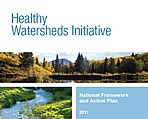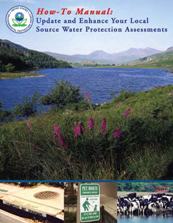Water: Climate Change and Water
Watersheds and Wetlands
Healthy watersheds and wetlands provide a host of ecological services, including water purification, ground water and surface flow regulation, wildlife habitat, flood and surge impact reduction, water temperature moderation, erosion control, and stream bank stabilization. They also store carbon and sequester other greenhouse gases. These ecosystems are already threatened by a number of stressors, and climate change will further exacerbate this situation.
Numerous resources and tools related to watersheds and wetlands are available: explore our resources.
What EPA Is Doing

- The Healthy Watersheds Initiative encourages states, local governments, watershed organizations, and others to take a strategic systems approach to conserving healthy watersheds, with a goal of protecting high-quality waters and preventing future water quality impairments.
The National Wetland Condition Assessment is a statistical survey of the quality of our Nation’s wetlands. During the summer of 2011, field crews collected data at over 1,179 sites, from Florida to Alaska. Field samples are being processed to assure the quality of the data collected, and then analyzed. A report detailing the results of this survey will be released in 2013.
Watershed Central provides state, local, and voluntary watershed management entities with the key tools, resources, guidance, and datasets to aide in a successful watershed management.
Working With Our Partners

- The U.S. Fish and Wildlife Service is the principal federal agency providing information to the public on the status of the nation’s wetlands. The Fish and Wildlife Service has developed a series of maps to show wetlands and deepwater habitats. This geospatial information is used by federal, state, and local agencies; academic institutions; and private industry for management, research, policy development, education, and planning activities.

- Through WaterSMART, the U.S. Department of the Interior, Bureau of Reclamation works with states, tribes, local governments, and nongovernmental organizations to pursue a sustainable water supply for the nation. It establishes a framework to provide federal leadership and assistance on the efficient use of water, integrates water and energy policies to support the sustainable use of all natural resources, and coordinates water conservation activities.

- The U.S. Forest Service has programs in watershed restoration, water rights and uses, surface water, ground water, and riparian areas and wetlands. Program leaders support regional and field scientists and managers as well as line officers by providing technical guidance to conserve, protect, and restore the soil, riparian, water, and aquatic resources of national forests and grasslands.
Climate and Water Strategy
Our Goals:

- Identify, protect and maintain a network of healthy watersheds and supportive habitat corridor networks.
- Incorporate climate resilience into watershed restoration and floodplain management.
- Incorporate source water protection into watershed protection practices to protect drinking water supplies.
- Incorporate climate change considerations into the Clean Water Act regulatory program as they relate to permit reviews and compensatory mitigation.
- Improve baseline information on wetland extent, condition, and performance to inform effective adaptation to climate change.
To learn more, read the Watersheds and Wetlands section of the National Water Program 2012 Strategy: Response to Climate Change.
Featured Items
Identifying and Protecting Healthy Watersheds: Concepts, Assessments, and Management Approaches (EPA 2012) This technical document summarizes the many examples from across the country of state, local government, and others efforts to assess, identify, and protect healthy watersheds by understanding their systems context.

How-To Manual: Update and Enhance Your Local Source Water Protection Assessments (PDF) (36 pp, 656K, About PDF) This manual is intended to help source water protection partners protect the raw sources of their drinking water from potential contaminant sources.
